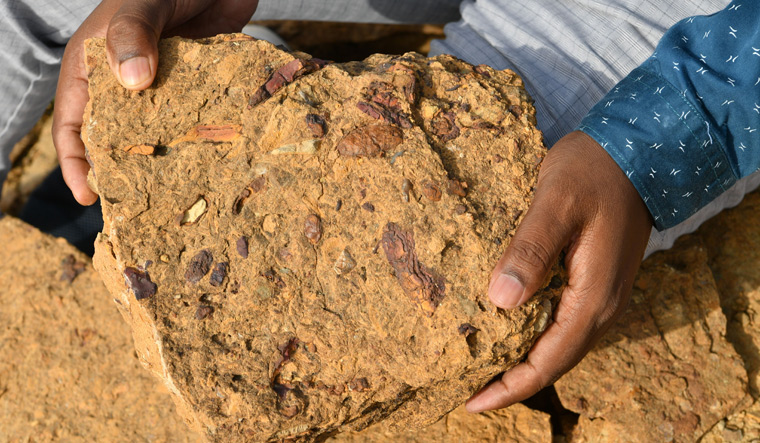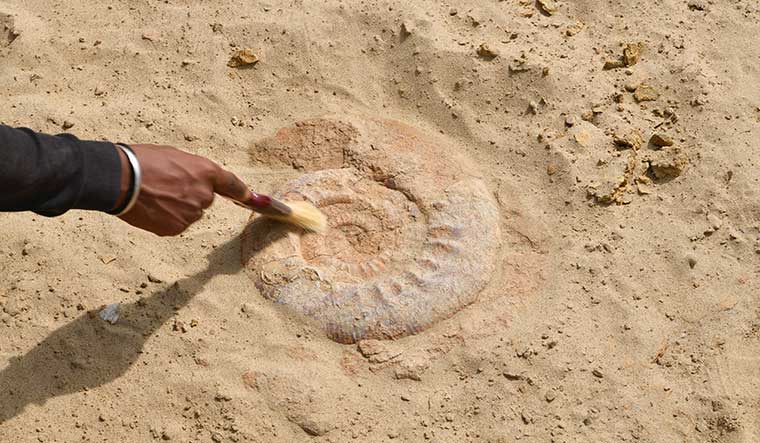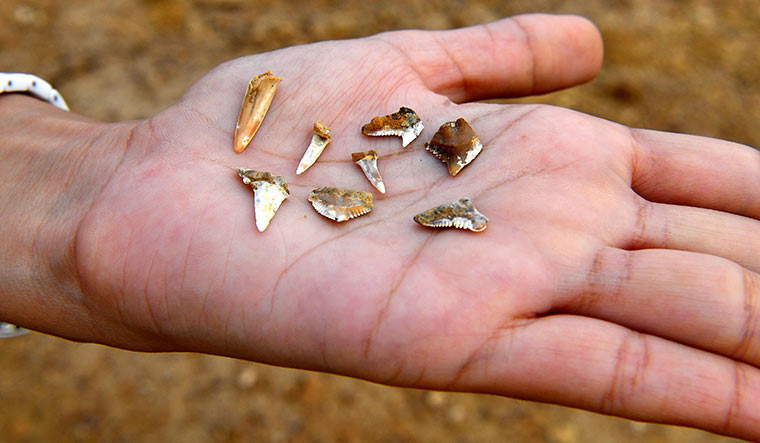Krishna Kumar, 39, has a childlike sense of wonder about dinosaurs. A palaeontologist with the Geological Survey of India, he has been walking over their remains often. While at work, he calls them “vertebrate fossils assemblages from the Mesozoic era”.
Unsurprisingly, back in 2017, when Kumar was doing his fieldwork in Rajasthan, scanning an uninhabited stretch along the Jaisalmer-Kanod road—about 3km southeast of Jethwai village—he was looking for dinosaur fossils. After all, the soil beneath his feet, composed of crushed yellowish limestone and marl, was splendidly fossiliferous—with organic remains ranging from early Jurassic to the Middle Eocene (250 to 40 million years). Instead, he stumbled onto a conical, white object embedded in a rocky outcrop. Shining in the sun, it looked remarkably well preserved.
“My heart jumped and I knew this was it,” recalls Kumar, standing in the same spot on a crisp October morning this year. Four years ago, he couldn’t have known it was the tooth of a prehistoric shark called hybodont, which are the closest cousins of modern sharks and rays. Only when he came back to his lab in Jaipur, contacted experts and compared published literature did he grasp the rarity of his find.
Hybodonts, known as “opportunist predators”, have been found in marine deposits of the western world. They are believed to have first appeared around 360 million years ago and became extinct at the end of the Cretaceous era, which was roughly 66 million years ago. But Jurassic-era hybodonts are very rare in the Indian subcontinent. There is one from the Kota formation of Pranhita-Godavari basin in the southern peninsula.
“But the hybodont from the Jaisalmer basin is a much older one and an entirely new species,” says Kumar, dating the shark fossil from the desert back to at least 165 million years. Belonging to the genus Strophodus, which itself is a first such find in the Indian subcontinent, the hybodont teeth in Jaisalmer has a more intricate surface ornamentation with greater thickness, indicating a whole new species of shark. It was named Jaisalmerensis—a school of which is now believed to have roamed the seas in early Jurassic Rajasthan.
Shuffling the varied, broken bunch of Jaisalmerensis teeth in his pocket, Kumar points to a hill in the isolated stretch of land not very far from the majestic Sonar Kella. “You see this hill over there? That’s where I found the first shark tooth,” says Kumar. Even before he is done pointing out the rock pile, he reacts to our feet crunching gravel. “That’s yet another hybodont you just stepped on,” he jumps with joy, his eyes sparkling with the thrill of a discovery as he picks up rock after rock studded with shark teeth of varying sizes and textures—rough and blunt to button-shaped shiny.
Anterior-Lateral tooth meant for crushing the prey, just like human molars. “We have also found teeth as big as four centimetres, which might make the Jaisalmerensis about three metres in height,” says Kumar. And suddenly the rock formation around us, spread across seven to eight kilometres, seems like the turquoise of the sea.
HARK! A SHARK
From riverbeds and mountaintops to deserts and the Antarctic ice, shark teeth fossils are quite widespread in marine deposits. Sharks continuously produce and shed their teeth; a lemon shark variety produces 20,000 in half its lifetime. And the teeth fossilise better than the cartilaginous skeleton, which deteriorates once the animal dies. In parts of Jaisalmer, this cluster of teeth continues to be strewn around, casually jutting out of surface rocks. To an unsuspecting eye, they can be easily dismissed as pebbles or animal bones. “People should be able to find fossils later, too. We don’t take everything home. You are seeing this after millions of years. That is a magical thing,” says Kumar, who with his team of geologists collected 50 different types of hybodont teeth near Jethwai village and catalogued 34 such specimens in a paper published on Jaisalmerensis in August this year. The paper, published in Historical Biology, was co-authored by Kumar, Sunil Bajpai, Pragya Pandey, Triparna Ghosh and Debasish Bhattacharya, and was widely reported in the media.
Bajpai, head of the department of Earth Sciences at IIT Roorkee, is one of the leading experts on fossils in India. He has been collecting some of the rarest ones for the last 35 years and has some 2,000 of them displayed in a museum at IIT Roorkee. He is also Kumar’s beloved mentor and guru who has been supervising the GSI project on hybodonts from the beginning. He says the last evidence of sea in the Jaisalmer region goes back to some 40 million years ago. A village in Jaisalmer district—Bandah—is where the youngest of shark teeth were found in 2016.
Jaisalmerensis is 125 million years older than the shark remains found in Bandah. “But if we reported it for the first time doesn’t mean that a lot of people tried before us and failed. The fact is that not many people have tried looking for marine fossils in the Jaisalmer region,” says Bajpai, who informs that the Jaisalmer Formation (sedimentary basin) was first mapped and described by a British geologist Richard Dixon Oldham in 1886. “It’s the area he mentioned that we have gone back to. But he did not do much work on vertebrate fossils like sharks, which are typically found in pockets. And it always starts with scattered bones and teeth,” says Bajpai.
The crusher teeth of Jaisalmerensis were flat, he says, which meant they used a good deal of brute force to crush and grind their prey—a mighty ferocious beast. “Judging by the size of the teeth we have found, they might have been like monsters,” says Bajpai. He says that they also found ancient wood fossils along with remains of other land animals. “This implies that these sharks roamed the shallow waters, near to shore,” he says.
But what about ever finding other skeletal remains of this mysterious shark? Early this year, in fact, a team of palaeontologists from Austria and Switzerland unearthed a remarkably intact skeleton of a species of hybodontiform shark at least 150 million years old in the Solnhofen limestones of Germany. Called Asteracanthus, its full dentition could contain 150 teeth and it was up to 3m long. “Asteracanthus was certainly not only one of the largest cartilaginous fishes of its time, but also one of the most impressive,” says a January report on the first-of-its-kind discovery.
Is it possible that a well-articulated skeleton of Jaisalmerensis lies hidden in the bowels of the rock piles of Jethwai? “If we find a skeleton we are very lucky. We have to estimate where we are likely to find it. Rock formation here is an admixture of many things. And sandstone doesn’t preserve fossils easily,” says Kumar. But Bajpai is more optimistic, banking on the patience and perseverance of a determined geologist. “If you are hardworking and lucky, you may hit upon a nice big skeleton, too,” he says.
THE DEAD SEA
A quick Google search on Kuldhara village in Jaisalmer throws up the haunted settlement shtick for tourists. An abandoned village with sandstone houses and façades in varied states of disrepair, an entire cast of Paliwal Brahmins left their houses overnight and disappeared some 200 years ago. The reason for their departure could be a drought or an earthquake or the repressive tendencies of a state minister.
They say the Kuldhara village was cursed; even the treasures buried beneath its ruins cannot tempt locals to set up homes there. But few know about the cache of marine treasures that lie further down the village in a section called the Kuldhara Nala, which has come to be a geological hub. It is particularly known for an extinct marine mollusc called ammonite, which disappeared some 66 million years ago.
The presence of these large spiral shells, coiled like a snake with sutures, pretty much always affirms the age of the rocks in which they solidify. Kumar digs out a perfectly patterned ammonite from the folds of the sand; it is the closest cousin of the living fossil nautilus. Sized 30-40cm, ammonite is one of the largest marine fossils quite easily available, so much so that peddlers often approach tourists visiting Kuldhara with fully formed fossils.
“Students from every department of geology come here every year. There’s now a wealth of literature on the invertebrate fossil from the Kuldhara Nala section. Nala is the name of the Marsidi river that ran through this area centuries ago. You are sitting on a riverbed,” says Kumar as he plucks out brachiopods littered all over the ground—yet another marine animal which first appeared some 540 million years ago and are rarely found today in seas and oceans. These bottom-dwelling lamp shell-like creatures attached themselves to the substrate of the ocean floor. “There is a cremation site for the lost inhabitants of Kuldhara village nearby. But this is also a graveyard of brachiopods,” says Kumar, giving further evidence of a Jaisalmer residing beneath the dark blue waves.
“Ammonites are extinct relatives of modern squids and octopus-like animals. When they appear, they appear in hundreds,” says Bajpai, who informs that these ammonites were possibly devoured by the Jaisalmerensis. “The sharks needed to break open their shells. And if you really want to break the surface shell in order to eat the animal inside then you have to have a tooth structure designed to crush it. And a flat surface can crush more efficiently; a needle-like pointed tooth can only puncture the prey.”
But it was in the Bandah formation, two kilometres northeast of Bandah village in Jaisalmer district, that Kumar first found a smattering of shark teeth about 45 million years old in 2016. He takes us to the locality where he found a full bounty of vertebrate collection including whale bones, spinal column of a crocodile and a shark, rayfish teeth, catfish bone fragments, snails and slugs embedded in the rocks. “But when I first saw shark teeth here, I was jumping with joy. We had our camp in Ramgarh and we celebrated with a chicken party,” remembers Kumar as he digs out an assortment of teeth from the soil again, his trained eye easily identifying the small denticles with sharp, finely serrated edges.
He soon picks up a handful of button-shaped benthic foraminifers fossils from the ground, which resembles a gravelly beach in the evening sun. The presence of formanifers, which are amoeba-like single-celled organisms, indicate a warm, marine environment going back to the middle eocene, that is around 45 million years ago. “We have taken out eight species of shark teeth here. This gave us the confidence to look for more. And then we found Jaisalmerensis. Who knows what’s next,” Kumar says; his face aglow with anticipation as he awaits the next day to revisit Jethwai and continue his search for the remains of Jaisalmerensis.







